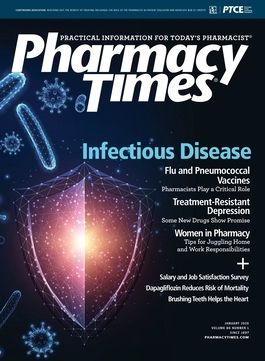Publication
Article
Pharmacy Times
Offer the Facts on Adverse Effects of the Influenza Vaccine
Author(s):
Pharmacists can ease fears and offer counseling to dispel common misconceptions and myths and help promote immunization.
With the influenza season well under way, the majority of individuals who elected to get the annual influenza vaccination have most likely already received it.
However, according to the CDC, as long as the influenza virus is circulating, it is not too late to get the vaccine.1
Vaccines are considered one of the most costeffective protective measures against preventable diseases. They are not 100% effective, but an annual influenza vaccination offers important protection against influenza illness and its potentially serious complications. Yet for many patients, misconceptions and the fear of adverse effects (AEs) are often barriers to obtaining vaccines.
Just an estimated 52% of adults in the United States plan to get the influenza vaccine this season, according to new data from the National Foundation for Infectious Diseases. The top reasons cited for not getting vaccinated were belief that the influenza vaccine doesn’t work (51%), concern about vaccinerelated AEs (34%), and concern about getting influenza from the vaccine (22%).2 Pharmacists play a fundamental role in dispelling common concerns about AEs and improving vaccination rates, and they can act as advocates and educators, as well as vaccine administrators.
During patient counseling sessions about the pros and cons of vaccinations, pharmacists can also provide patients with pertinent information regarding the potential AEs associated with influenza vaccinations and how to best manage these symptoms.
Most AEs associated with influenza vaccinations are minor and may include a low-grade fever and redness or soreness at the injection site, according to the CDC.3 Pharmacists can ease fears by reminding patients that mild pain and soreness are to be expected after receiving an influenza vaccination and that these effects typically resolve on their own after 24 to 48 hours. Advise patients to use a cold compress on the area and/or take an OTC analgesic, such as acetaminophen, ibuprofen, or naproxen sodium. Prior to recommending the use of these OTC agents, pharmacists should assess the patient’s medical history to ascertain if there are any potential contraindications, such as an allergy, a medical condition, or possible drug-drug interactions. In addition, to guard against and address reactions immediately, many facilities that administer vaccinations, including convenient-care clinics, pharmacies, and physicians’ offices, require patients to wait at least 15 minutes after administration of a vaccine to monitor for potential allergic reactions. It is important that patients are educated about these potential AEs and measures to best handle them should they occur, as well as when to contact their primary health care providers.
The CDC has patient information sheets available with its recommendations for addressing AEs that are associated with the influenza vaccine, including the inactivated injection form and the live nasal formulation.4
In rare cases, arm pain associated with the influenza vaccine may be the result of improper vaccine administration, referred to as shoulder injury related to vaccine administration (SIRVA). This preventable occurrence is caused by injecting a vaccine into the shoulder capsule rather than the deltoid muscle.5 Subsequently, inflammation of the shoulder structures affects quality of life, causing pain and decreased range of motion. Although a dull muscle ache after a vaccine injection is common, that pain disappears within a few days.5 In contrast, SIRVA-related pain begins within 48 hours of vaccine administration and does not improve with the use of an OTC analgesic.5 In a recent publication, Bancsi et al reiterated the need for health care professionals, including pharmacists, to take precautions to minimize the risk of their patients developing SIRVA.5 Most importantly, those who administer vaccines must recognize the anatomical landmarks for identifying the deltoid muscle and use proper intramuscular administration technique.6
CONCLUSION
The CDC emphasizes that although the efficacy of the vaccine varies annually, the influenza vaccine remains the most effective tool a patient can use to prevent contracting the influenza virus and experiencing its potentially severe consequences.7 Recent study results also confirm that receiving the influenza vaccine may reduce the severity of the infection, even when the vaccine does not prevent influenza itself. The results showed that the vaccine lessened the risk of severe influenza among adults and of flu-related hospitalization and admission to the intensive care unit.7 Educating patients about the effectiveness and safety of the influenza vaccine and dispelling misconceptions and myths can empower patients to make informed decisions about their health and ease fears about potential AEs. An excellent patient education tool from the CDC can be found at cdc.gov/flu/prevent/misconceptions.htm.
Yvette C. Terrie, BSPharm, RPh, is a consulting pharmacist and a medical writer in Haymarket, Virginia.
REFERENCES
- Children & influenza (flu). cdc.gov/flu/highrisk/children.htm. CDC website. Updated October 23, 2019. Accessed November 9, 2019.
- Only 52% of US adults plan to get flu vaccine, survey shows. Healio Infectious Disease News website. healio.com/infectious-disease/influenza/news/online/%7Bbf3b0c1fab10-4c4c-9bd2-31ca50c347c1%7D/only-52-of-us-adults-plan-to-get-flu-vaccinesurvey-shows. Published September 26, 2019. Accessed November 9, 2019.
- College of Physicians of Philadelphia. Vaccine side effects and adverse events. The History of Vaccines website. historyofvaccines.org/content/articles/vaccine-sideeffects-and-adverse-events. Updated January 17, 2018. Accessed November 9, 2019.
- CDC. Vaccine information statements. cdc.gov/vaccines/hcp/vis/vis-statements/flu.html. Updated August 14, 2019. Accessed December 13, 2019.
- Bancsi A, Houle SKD, Grindrod KA. Shoulder injury related to vaccine administration and other injection site events. Can Fam Physician. 2019;65(1):40-42.
- Wexler D. Technically speaking: let’s get it right! how to avoid shoulder injury with deltoid intramuscular injections. Immunization Action Coalition website. immunize.org/technically-speaking/20181023.asp. Updated November 8, 2018. Accessed November 11, 2019.
- Roche GC. Flu vaccine reduces virus severity in patients, regardless of prevention. MD Magazine website. mdmag.com/medical-news/flu-vaccinereduces-virus-severity-patients-prevention. Published January 23, 2019. Accessed November 11, 2019.







